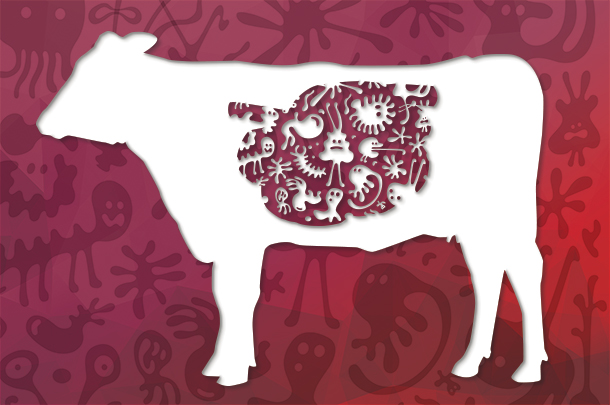The Role of Direct-Fed Microbes to Ruminants: A Review
Abstract
Feed additives are used in livestock feed and feeding to increase feed quality, the utility of feed derived from animals, and the performance and health of the animals. Digestibility gravies, rumen flora stabilizers, and microbial are some of the zoo's technological additions. Direct feed microbial are characterized as microbial-based feed additives, with a tighter definition than probiotics. It improves feed use by boosting energy usage per unit of feed and enhancing fiber digestibility. The term direct-fed microbial (DFM) was coined by the Food and Drug Administration and the American Feed Regulator Representatives Associations to describe a feed product that contains live, naturally occurring microorganisms such as bacteria, fungi, and yeast; the bacteria can produce or consume lactic acid. Microbial feed additives have traditionally been given to animals during stressful times in the hopes of establishing a beneficial microbe population in the digestive tract, which would reduce or prevent harmful organism development. DFM has several mechanisms of action, some of which affect the rumen and others which affect the gastrointestinal system. Lactic acid-generating bacteria (LAB) have a favorable impact on the rumen by reducing ruminal acidosis, encouraging the proliferation of ruminal microorganisms that have adapted to the presence of lactic acid in the rumen, and boosting lactic acid-using bacteria (LUB). LUB has been presented as a DFM that can lower lactate levels while maintaining ruminal pH. Through hydrophobic interactions, DFM can block or prevent pathogens like Escherichia coli from attaching to the intestinal mucosa. DFM medication helps dairy calves adapt quickly to solid feed by speeding up the formation of ruminal and intestinal microbes and preventing the spread of enteric pathogens, which can cause diarrhea. DFM was utilized to improve dairy cow performance by improving dry matter intake, milk output and protein content, as well as blood glucose and insulin levels before and after delivery. DFM is critical in beef cattle to prevent ruminal acidosis induced by highly fermentable diets, as well as to promote growth, meat output, and feed efficiency. Powders, pastes, boluses, and capsules are only some of the direct-fed microbial products available. It can be added to feed or ingested by drinking water. According to one study, feeding more than 107 CFU per head per day may cause lower nutrient absorption due to overpopulation in the gastrointestinal tract.
Downloads
References
Abu-Tarboush, H. M., Al-Saiady, M. Y., & El-Din, A. H. K. (1996). Evaluation of diet containing lactobacilli on performance, fecal coliform, and lactobacilli of young dairy calves. Animal Feed Science and Technology, 57(1-2), 39-49.
Adams, M. C., Luo, J., Rayward, D., King, S., Gibson, R., & Moghaddam, G. H. (2008). Selection of a novel direct-fed microbial to enhance weight gain in intensively reared calves. Animal Feed Science and Technology, 145(1-4), 41-52.
Aschenbach, J. R., Penner, G. B., Stumpff, F., & Gäbel, G. (2011). Ruminant nutrition symposium: Role of fermentation acid absorption in the regulation of ruminal pH. Journal of animal science, 89(4), 1092-1107.
Beauchemin, K. A., Eriksen, L., Nørgaard, P., & Rode, L. M. (2008). Salivary secretion during meals in lactating dairy cattle. Journal of Dairy Science, 91(5), 2077-2081.
Beauchemin, K. A., Yang, W. Z., Morgavi, D. P., Ghorbani, G. R., Kautz, W., & Leedle, J. A. Z. (2003). Effects of bacterial direct-fed microbials and yeast on site and extent of digestion, blood chemistry, and subclinical ruminal acidosis in feedlot cattle. Journal of Animal Science, 81(6), 1628-1640.
Bozic, M., Newton, J., Thraen, C. S., & Gould, B. W. (2012). Mean-reversion in income over feed cost margins: Evidence and implications for managing margin risk by US dairy producers. Journal of dairy science, 95(12), 7417-7428.
Chiquette, J., Allison, M. J., & Rasmussen, M. A. (2008). Prevotella bryantii 25A used as a probiotic in early-lactation dairy cows: effect on ruminal fermentation characteristics, milk production, and milk composition. Journal of Dairy Science, 91(9), 3536-3543.
Dicks, L., & Botes, M. (2010). Probiotic lactic acid bacteria in the gastro-intestinal tract: health benefits, safety and mode of action. Beneficial microbes, 1(1), 11-29.
Elam, N. A., Gleghorn, J. F., Rivera, J. D., Galyean, M. L., Defoor, P. J., Brashears, M. M., & Younts-Dahl, S. M. (2003). Effects of live cultures of Lactobacillus acidophilus (strains NP45 and NP51) and Propionibacterium freudenreichii on performance, carcass, and intestinal characteristics, and Escherichia coli strain O157 shedding of finishing beef steers. Journal of Animal Science, 81(11), 2686-2698.
Elghandour, M. M., Salem, A. Z., Castañeda, J. S. M., Camacho, L. M., Kholif, A. E., & Chagoyán, J. C. V. (2015). Direct-fed microbes: A tool for improving the utilization of low quality roughages in ruminants. Journal of Integrative Agriculture, 14(3), 526-533.
Enemark, J. M. (2008). The monitoring, prevention and treatment of sub-acute ruminal acidosis (SARA): A review. The Veterinary Journal, 176(1), 32-43.
Frizzo, L. S., Soto, L. P., Zbrun, M. V., Bertozzi, E., Sequeira, G., Armesto, R. R., & Rosmini, M. R. (2010). Lactic acid bacteria to improve growth performance in young calves fed milk replacer and spray-dried whey powder. Animal Feed Science and Technology, 157(3-4), 159-167.
Ghorbani, G. R., Morgavi, D. P., Beauchemin, K. A., & Leedle, J. A. Z. (2002). Effects of bacterial direct-fed microbials on ruminal fermentation, blood variables, and the microbial populations of feedlot cattle. Journal of Animal Science, 80(7), 1977-1985.
Holzapfel, W. H., Haberer, P., Snel, J., Schillinger, U., & in't Veld, J. H. H. (1998). Overview of gut flora and probiotics. International journal of food microbiology, 41(2), 85-101.
Hong, H. A., Duc, L. H., & Cutting, S. M. (2005). The use of bacterial spore formers as probiotics. FEMS microbiology reviews, 29(4), 813-835.
Huntington, G. B. (2000). High-starch rations for ruminant production discussed. Feedstuffs. 23,12-13.
Hutcheson, D. P., Cole, N. A., Keaton, W., Graham, G., Dunlap, R., & Pittman, K. (1981). Use of a living, nonfreeze-dried Lactobacillus acidophilus culture for receiving feedlot calves. Progress Report-Texas Agricultural Experiment Station (USA).
Jung, H. G., & Allen, M. S. (1995). Characteristics of plant cell walls affecting intake and digestibility of forages by ruminants. Journal of animal science, 73(9), 2774-2790.
Knapp, J. R., Laur, G. L., Vadas, P. A., Weiss, W. P., & Tricarico, J. M. (2014). Invited review: Enteric methane in dairy cattle production: Quantifying the opportunities and impact of reducing emissions. Journal of dairy science, 97(6), 3231-3261.
Krehbiel, C. R., Rust, S. R., Zhang, G., & Gilliland, S. E. (2003). Bacterial direct-fed microbials in ruminant diets: Performance response and mode of action. Journal of Animal Science, 81(14_suppl_2), E120-E132.
Kullen, M. J., & Klaenhammer, T. R. (2000). Genetic modification of intestinal lactobacilli and bifidobacteria. Current issues in molecular biology, 2(2), 41-50.
Kung Jr L. (2006). Direct-fed microbial and enzyme feed additives. In: 2006 Direct-Fed Microbial, Enzyme and Forage Additive Compendium. Miller Publishing, Minnetonka, MN.
Kung Jr, L. (2001). Direct-fed microbials for dairy cows and enzymes for lactating dairy cows: New theories and applications. In 2001 Pennsylvania State Dairy Cattle Nutrition Workshop (pp. 86-102). Grantville PA.
Kung, L. J. (2006). Direct fed microbials and enzymes for dairy cows. department of Animal and Food Science University of Delaware Newark, DL,USA.
Lynch, H. A., & Martin, S. A. (2002). Effects of Saccharomyces cerevisiae culture and Saccharomyces cerevisiae live cells on in vitro mixed ruminal microorganism fermentation. Journal of Dairy Science, 85(10), 2603-2608.
Martin, C., Devillard, E., & Michalet-Doreau, B. (1999). Influence of sampling site on concentrations and carbohydrate-degrading enzyme activities of protozoa and bacteria in the rumen. Journal of animal science, 77(4), 979-987.
Newbold, C. J., Wallace, R. J., & McIntosh, F. M. (1996). Mode of action of the yeast Saccharomyces cerevisiae as a feed additive for ruminants. British Journal of Nutrition, 76(2), 249-261.
Nocek, J. E., & Kautz, W. P. (2006). Direct-fed microbial supplementation on ruminal digestion, health, and performance of pre-and postpartum dairy cattle. Journal of Dairy Science, 89(1), 260-266.
Nocek, J. E., Kautz, W. P., Leedle, J. A. Z., & Allman, J. G. (2002). Ruminal supplementation of direct-fed microbials on diurnal pH variation and in situ digestion in dairy cattle. Journal of Dairy Science, 85(2), 429-433.
Nocek, J. E., Kautz, W. P., Leedle, J. A. Z., & Block, E. (2003). Direct-fed microbial supplementation on the performance of dairy cattle during the transition period. Journal of dairy science, 86(1), 331-335.
Oetzel, G. R., Emery, K. M., Kautz, W. P., & Nocek, J. E. (2007). Direct-fed microbial supplementation and health and performance of pre-and postpartum dairy cattle: A field trial. Journal of dairy science, 90(4), 2058-2068.
Orr, C. L., Ware, D. R., Manfredi, E. T., & Hutcheson, D. P. (1988). The effect of continuous feeding of Lactobacillus acidophilus strain BT1386 on gain and feed efficiency of feeder calves. J. Anim. Sci, 66(Suppl 1), 460.
Parvez, S., Malik, K. A., Ah Kang, S., & Kim, H. Y. (2006). Probiotics and their fermented food products are beneficial for health. Journal of applied microbiology, 100(6), 1171-1185.
Poppy, F. (2008). feed additives in ruminant nutrition, agriculture &development board pp 6
Prieto, M. L., O’Sullivan, L., Tan, S. P., McLoughlin, P., Hughes, H., Gutierrez, M., ... & Gardiner, G. E. (2014). In vitro assessment of marine Bacillus for use as livestock probiotics. Marine drugs, 12(5), 2422-2445.
Seo, J. K., Kim, S. W., Kim, M. H., Upadhaya, S. D., Kam, D. K., & Ha, J. K. (2010). Direct-fed microbials for ruminant animals. Asian-Australasian Journal of Animal Sciences, 23(12), 1657-1667.
Tharwat, M., Al-Sobayil, F., Ali, A., & Buczinski, S. (2012). Transabdominal ultrasonographic appearance of the gastrointestinal viscera of healthy camels (Camelus dromedaries). Research in veterinary science, 93(2), 1015-1020.
Van Soest, P. J. (1994). Nutritional ecology of the ruminant. Cornell university press.
Weiss, W. P., Wyatt, D. J., & McKelvey, T. R. (2008). Effect of feeding propionibacteria on milk production by early lactation dairy cows. Journal of Dairy Science, 91(2), 646-652.
Yang, W. Z., Beauchemin, K. A., Vedres, D. D., Ghorbani, G. R., Colombatto, D., & Morgavi, D. P. (2004). Effects of direct-fed microbial supplementation on ruminal acidosis, digestibility, and bacterial protein synthesis in continuous culture. Animal Feed Science and Technology, 114(1-4), 179-193.
Yoon, I. K., & Stern, M. D. (1995). Influence of direct-fed microbials on ruminal microbial fermentation and performance of ruminants: A review. Asian-Australasian Journal of Animal Sciences, 8(6), 533-555.

Copyright (c) 2022 Tesfa Kassa, Zemedkun Diffe

This work is licensed under a Creative Commons Attribution-NonCommercial-NoDerivatives 4.0 International License.










